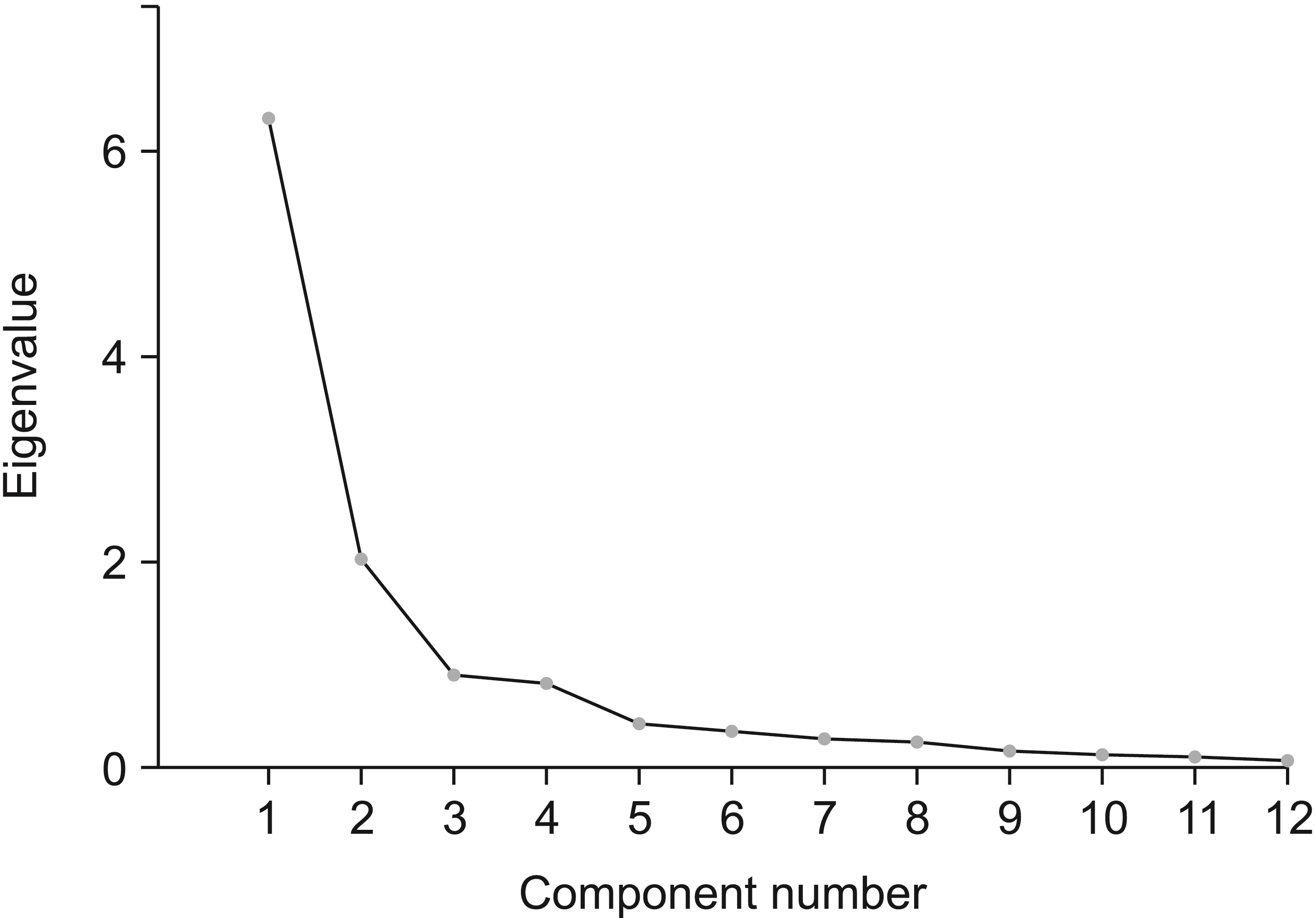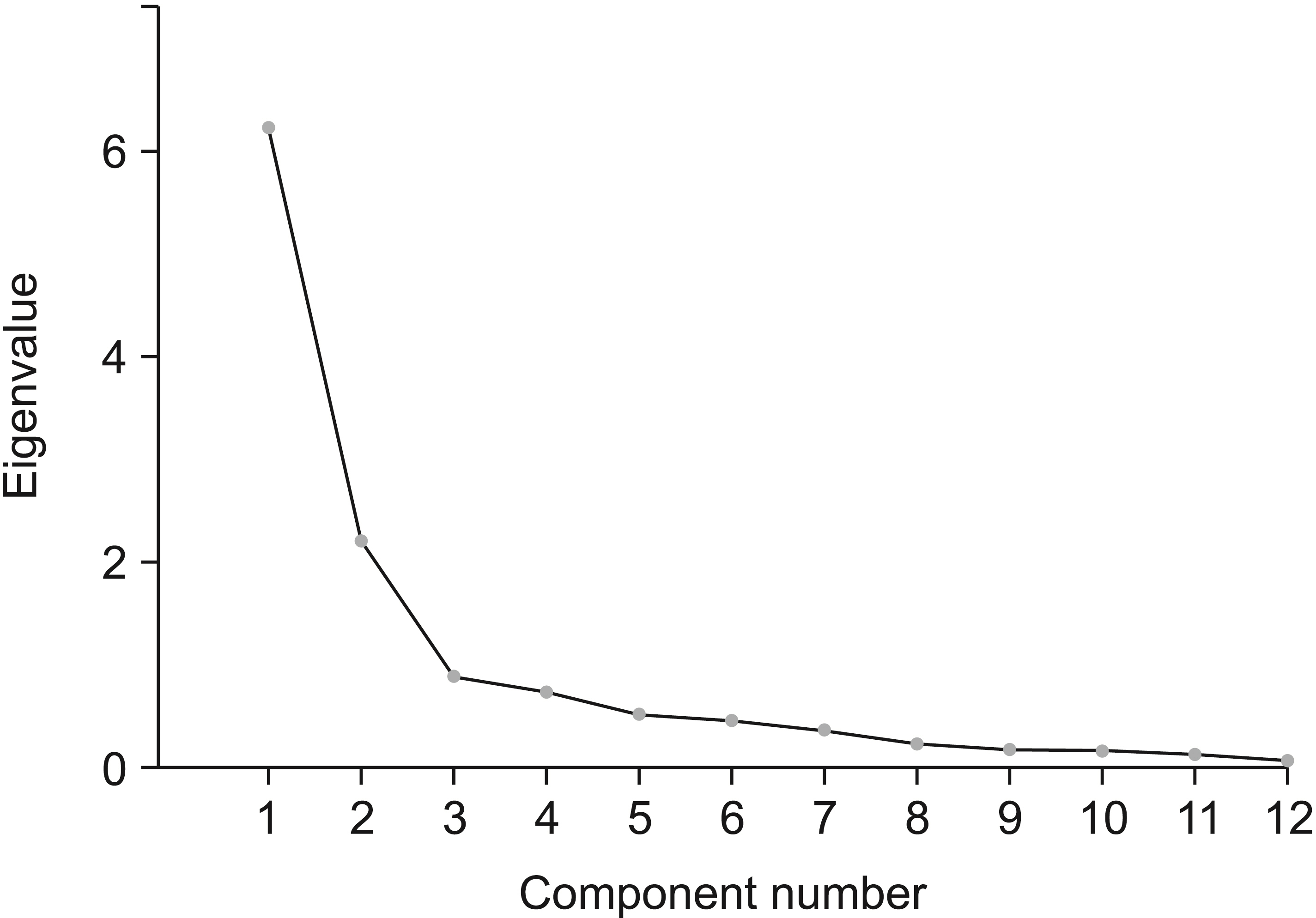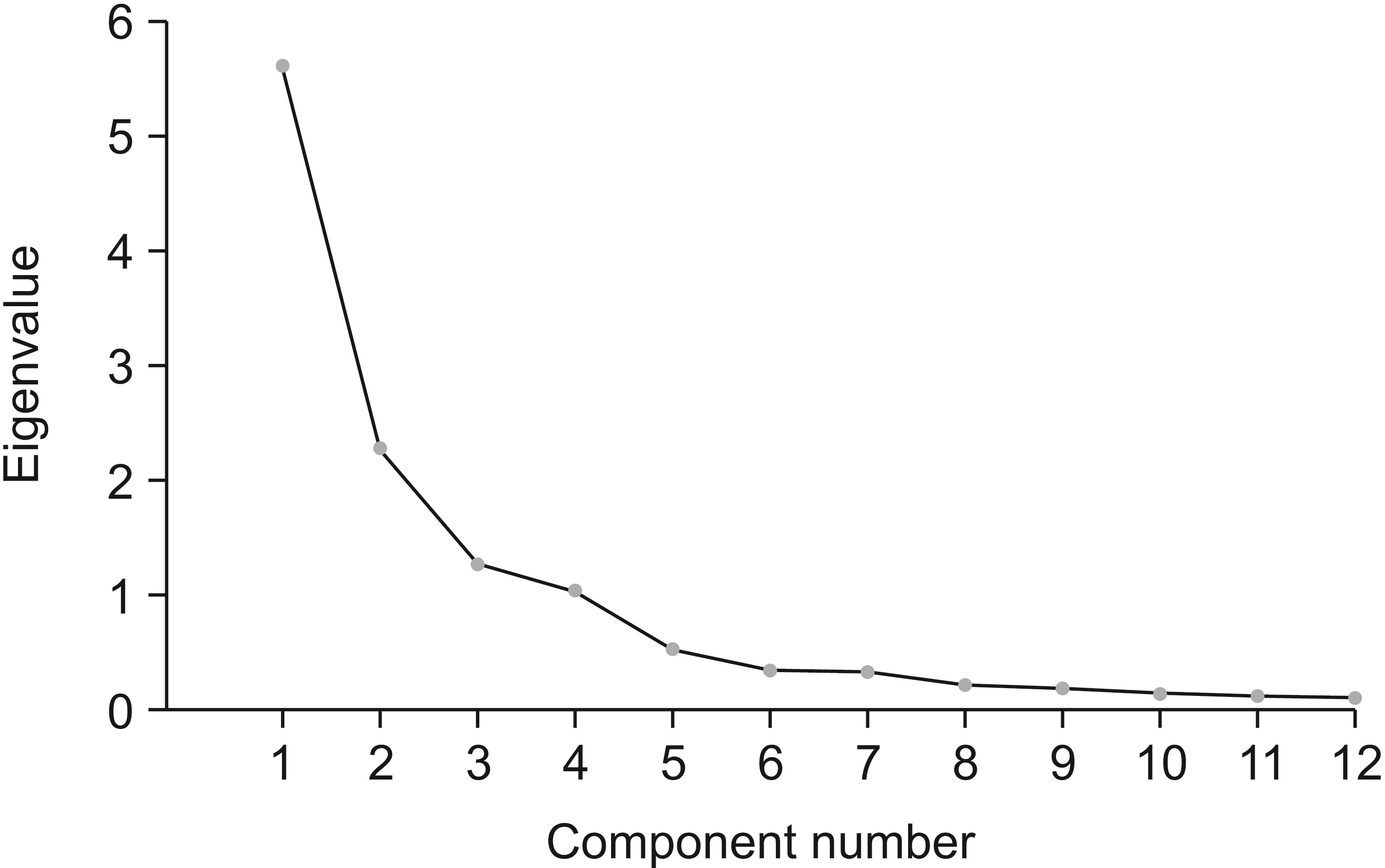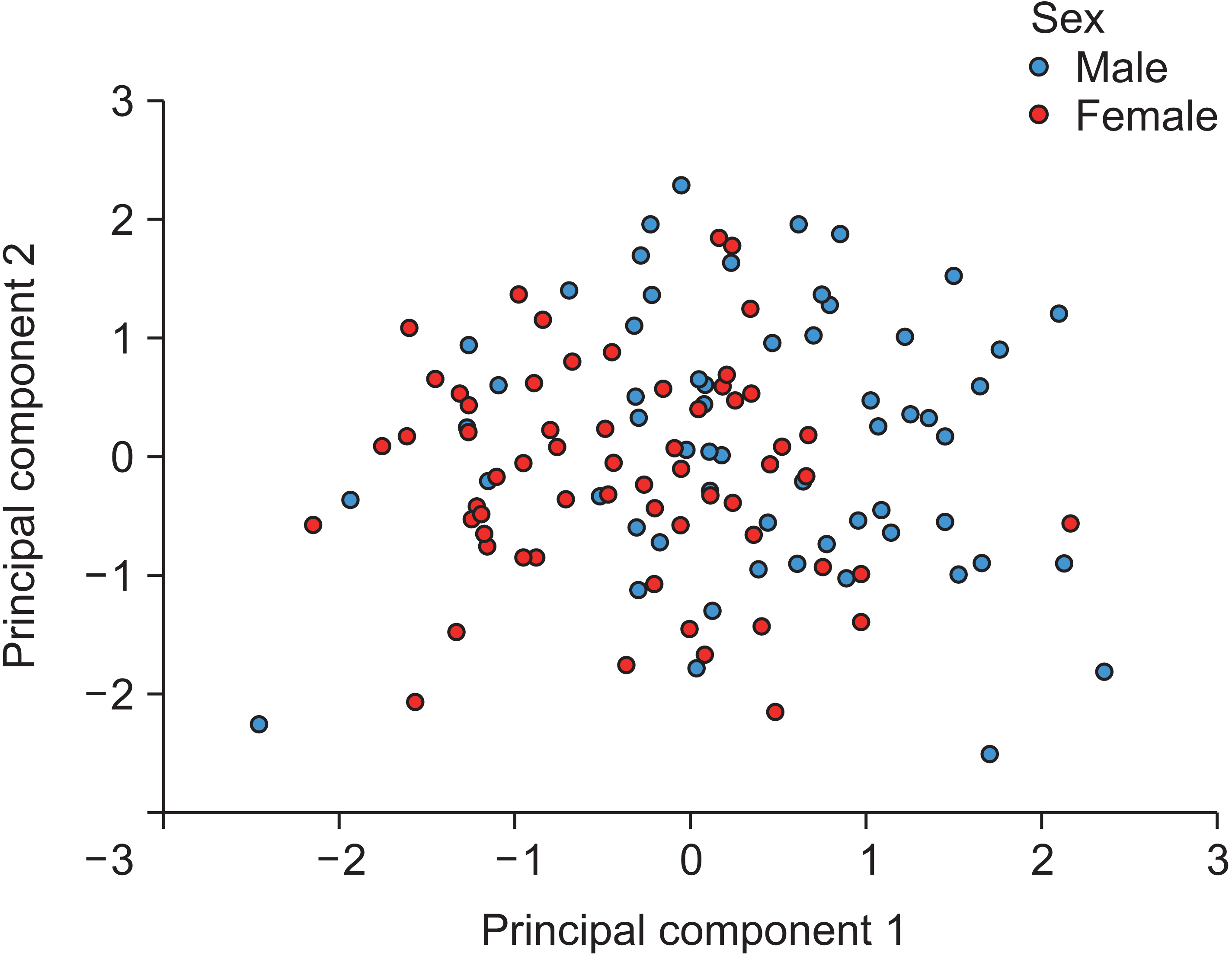Korean J Orthod.
2023 May;53(3):194-204. 10.4041/kjod22.250.
Artificial neural network model for predicting sex using dental and orthodontic measurements
- Affiliations
-
- 1Department of Orthodontics, School of Dental Medicine, University of Zagreb, Zagreb, Croatia
- 2Private Practice Policlinic IMED, Zagreb, Croatia
- 3Faculty of Dental Medicine and Health, Josip Juraj Strossmayer University of Osijek, Osijek, Croatia
- 4Department of Dental Anthropology, School of Dental Medicine, University of Zagreb, Zagreb, Croatia
- KMID: 2542814
- DOI: http://doi.org/10.4041/kjod22.250
Abstract
Objective
To investigate sex-specific correlations between the dimensions of permanent canines and the anterior Bolton ratio and to construct a statistical model capable of identifying the sex of an unknown subject.
Methods
Odontometric data were collected from 121 plaster study models derived from Caucasian orthodontic patients aged 12–17 years at the pretreatment stage by measuring the dimensions of the permanent canines and Bolton's anterior ratio. Sixteen variables were collected for each subject: 12 dimensions of the permanent canines, sex, age, anterior Bolton ratio, and Angle’s classification. Data were analyzed using inferential statistics, principal component analysis, and artificial neural network modeling.
Results
Sex-specific differences were identified in all odontometric variables, and an artificial neural network model was prepared that used odontometric variables for predicting the sex of the participants with an accuracy of > 80%. This model can be applied for forensic purposes, and its accuracy can be further improved by adding data collected from new subjects or adding new variables for existing subjects. The improvement in the accuracy of the model was demonstrated by an increase in the percentage of accurate predictions from 72.0–78.1% to 77.8–85.7% after the anterior Bolton ratio and age were added.
Conclusions
The described artificial neural network model combines forensic dentistry and orthodontics to improve subject recognition by expanding the initial space of odontometric variables and adding orthodontic parameters.
Figure
Reference
-
1. Dietrichkeit Pereira JG, Lima KF, Alves da Silva RH. 2020; Mandibular measurements for sex and age estimation in Brazilian sampling. Acta Stomatol Croat. 54:294–301. https://doi.org/10.15644/asc54/3/7. DOI: 10.15644/asc54/3/7. PMID: 33132392. PMCID: PMC7586899.
Article2. Kieser JA. 1990. Human adult odontometrics. Cambridge University Press;Cambridge: https://doi.org/10.1017/CBO9780511983610. DOI: 10.1017/CBO9780511983610. PMCID: PMC258591.
Article3. Machado V, Botelho J, Mascarenhas P, Mendes JJ, Delgado A. 2020; A systematic review and meta-analysis on Bolton's ratios: normal occlusion and malocclusion. J Orthod. 47:7–29. https://doi.org/10.1177/1465312519886322. DOI: 10.1177/1465312519886322. PMID: 31718451.
Article4. Capitaneanu C, Willems G, Jacobs R, Fieuws S, Thevissen P. 2017; Sex estimation based on tooth measurements using panoramic radiographs. Int J Legal Med. 131:813–21. https://doi.org/10.1007/s00414-016-1434-0. DOI: 10.1007/s00414-016-1434-0. PMID: 27534562.
Article5. Moon G, Sathawane R, Chandak R, Lanjekar A, Bhakte K, Sukhdeve V. 2021; Sex determination by odontometric diagonal measurements using discriminant function. J Indian Acad Oral Med Radiol. 33:208–14. https://doi.org/10.4103/jiaomr.jiaomr_260_20. DOI: 10.4103/jiaomr.jiaomr_260_20. PMID: 2a9ada19e9444d0daf4d7fa48f3818d9.
Article6. Jolliffe IT, Cadima J. 2016; Principal component analysis: a review and recent developments. Philos Trans A Math Phys Eng Sci. 374:20150202. https://doi.org/10.1098/rsta.2015.0202. DOI: 10.1098/rsta.2015.0202. PMID: 26953178. PMCID: PMC4792409.
Article7. Dreiseitl S, Ohno-Machado L. 2002; Logistic regression and artificial neural network classification models: a methodology review. J Biomed Inform. 35:352–9. https://doi.org/10.1016/s1532-0464(03)00034-0. DOI: 10.1016/S1532-0464(03)00034-0. PMID: 12968784.
Article8. Gamulin O, Škrabić M, Serec K, Par M, Baković M, Krajačić M, et al. 2021; Possibility of human gender recognition using Raman spectra of teeth. Molecules. 26:3983. https://doi.org/10.3390/molecules26133983. DOI: 10.3390/molecules26133983. PMID: 34210090. PMCID: PMC8271900. PMID: b6d86555e27f4afe8ec569be1f126caf.
Article9. Shanmuganathan S. Shanmuganathan S, Samarasinghe S, editors. 2016. Artificial neural network modelling: an introduction. Artificial neural network modelling. Springer;Cham: p. 1–14. https://link.springer.com/chapter/10.1007/978-3-319-28495-8_1. DOI: 10.1007/978-3-319-28495-8_1.
Article10. Bewes J, Low A, Morphett A, Pate FD, Henneberg M. 2019; Artificial intelligence for sex determination of skeletal remains: application of a deep learning artificial neural network to human skulls. J Forensic Leg Med. 62:40–3. https://doi.org/10.1016/j.jflm.2019.01.004. DOI: 10.1016/j.jflm.2019.01.004. PMID: 30639854.
Article11. Karamizadeh S, Abdullah SM, Manaf AA, Zamani M, Hooman A. 2013; An overview of principal component analysis. J Signal Inf Process. 4:173–5. https://doi.org/10.4236/jsip.2013.43B031. DOI: 10.4236/jsip.2013.43B031.
Article12. Adams D, Pilloud M. 2019; Sex estimation from dental crown and cervical metrics in a contemporary Japanese sample. Forensic Anthropol. 2:222–32. https://doi.org/10.5744/fa.2019.1008. DOI: 10.5744/fa.2019.1008.
Article13. Vodanović M, Demo Ž, Njemirovskij V, Keros J, Brkić H. 2007; Odontometrics: a useful method for sex determination in an archaeological skeletal population? J Archaeol Sci. 34:905–13. https://doi.org/10.1016/j.jas.2006.09.004. DOI: 10.1016/j.jas.2006.09.004.
Article14. Agrawal A, Manjunatha BS, Dholia B, Althomali Y. 2015; Comparison of sexual dimorphism of permanent mandibular canine with mandibular first molar by odontometrics. J Forensic Dent Sci. 7:238–43. https://pubmed.ncbi.nlm.nih.gov/26816466/. DOI: 10.4103/0975-1475.172449. PMID: 26816466. PMCID: PMC4714414.
Article15. Al Rifaiy MQ, Abdullah MA, Ashraf I. 1997; Dimorphism of mandibular and maxillary canine teeth in establishing sex identity. Saudi Dent J. 9:17–20. https://faculty.ksu.edu.sa/en/malrifaiy/publication/130693.16. Alam MK, Alzarea BK, Ganji KK, Kundi I, Patil S. 2019; 3D CBCT human adult odontometrics: comparative assessment in Saudi, Jordan and Egypt population. Saudi Dent J. 31:336–42. https://doi.org/10.1016/j.sdentj.2019.03.007. DOI: 10.1016/j.sdentj.2019.03.007. PMID: 31337937. PMCID: PMC6626302.
Article17. Kuntz TR, Staley RN, Bigelow HF, Kremenak CR, Kohout FJ, Jakobsen JR. 2008; Arch widths in adults with Class I crowded and Class III malocclusions compared with normal occlusions. Angle Orthod. 78:597–603. https://doi.org/10.2319/0003-3219(2008)078[0597:AWIAWC]2.0.CO;2. DOI: 10.2319/0003-3219(2008)078[0597:AWIAWC]2.0.CO;2. PMID: 18302456.
Article18. Strujić M, Anić-Milosević S, Mestrović S, Slaj M. 2009; Tooth size discrepancy in orthodontic patients among different malocclusion groups. Eur J Orthod. 31:584–9. https://doi.org/10.1093/ejo/cjp013. DOI: 10.1093/ejo/cjp013. PMID: 19339673.
Article19. Hashim H, Dweik YG, Al-Hussain H. 2018; An odontometric study of arch dimensions among Qatari population sample with different malocclusions. Int J Orthod Rehabili. 9:93–100. https://doi.org/10.4103/ijor.ijor_12_18. DOI: 10.4103/ijor.ijor_12_18.
Article20. Hashim HA, Al-Sayed N, Al-Hussain H. 2017; Bolton tooth size ratio among Qatari population sample: an odontometric study. J Orthod Sci. 6:22–7. https://doi.org/10.4103/2278-0203.197395. DOI: 10.4103/2278-0203.197395. PMID: 28197399. PMCID: PMC5278581. PMID: 014549fa1e9341c7ab90e8f0cec83cc0.
Article21. Alshahrani AA, Alshahrani I, Addas MK, Shaik S, Binhomran FM, AlQahtani J. 2020; The tooth size discrepancy among orthodontic patients and normal occlusion individuals from Saudi Arabia: a three-dimensional scan analysis of diagnostic casts. Contemp Clin Dent. 11:141–9. https://doi.org/10.4103/ccd.ccd_455_19. DOI: 10.4103/ccd.ccd_455_19. PMID: 33110327. PMCID: PMC7583543. PMID: 890f1a0968dd436c8b0d28e00b255518.
Article22. Sravya T, Dumpala RK, Guttikonda VR, Manchikatla PK, Narasimha VC. 2016; Mesiodistal odontometrics as a distinguishing trait: a comparative preliminary study. J Forensic Dent Sci. 8:99–102. https://pubmed.ncbi.nlm.nih.gov/27555727/. DOI: 10.4103/0975-1475.186368. PMID: 27555727. PMCID: PMC4970422.
Article23. Salam E, Khalifa A, Hassouna D. 2021; Odontometric analysis using CBCT for sexual dimorphism in Egyptian-Fayoum population in case of normal occlusion. Egypt Dent J. 67:1319–32. https://www.researchgate.net/publication/350802113_Odontometric_analysis_using_CBCT_for_sexual_dimorphism_in_Egyptian-Fayoum_population_in_case_of_normal_occlusion. DOI: 10.21608/edj.2021.66478.1542.
Article24. Gopakumar M, Hegde AM, Janardhanan L. 2013; Gender determination by odontometric parameters-a preliminary study. Indian J Contemp Dent. 1:1–4. https://www.researchgate.net/publication/271350078_Gender_Determination_by_Odontometric_Parameters-A_Preliminary_Study. DOI: 10.5958/j.2320-5962.1.1.001.
Article25. Sharma S, Sharma S, Athaiya A. 2020; Activation functions in neural networks. Int J Eng Appl Sci Technol. 4:310–6. https://doi.org/10.33564/IJEAST.2020.v04i12.054. DOI: 10.33564/IJEAST.2020.v04i12.054.
Article26. Obuchowski NA, Bullen JA. 2018; Receiver operating characteristic (ROC) curves: review of methods with applications in diagnostic medicine. Phys Med Biol. 63:07TR01. https://doi.org/10.1088/1361-6560/aab4b1. DOI: 10.1088/1361-6560/aab4b1. PMID: 29512515.
Article27. Centor RM. 1991; Signal detectability: the use of ROC curves and their analyses. Med Decis Making. 11:102–6. https://doi.org/10.1177/0272989X9101100205. DOI: 10.1177/0272989X9101100205. PMID: 1865776.
Article28. Murray PE, Stanley HR, Matthews JB, Sloan AJ, Smith AJ. 2002; Age-related odontometric changes of human teeth. Oral Surg Oral Med Oral Pathol Oral Radiol Endod. 93:474–82. https://doi.org/10.1067/moe.2002.120974. DOI: 10.1067/moe.2002.120974. PMID: 12029288.
Article29. Khamis MF, Taylor JA, Malik SN, Townsend GC. 2014; Odontometric sex variation in Malaysians with application to sex prediction. Forensic Sci Int. 234:183.e1–7. https://doi.org/10.1016/j.forsciint.2013.09.019. DOI: 10.1016/j.forsciint.2013.09.019. PMID: 24128748.
Article30. Narang RS, Manchanda AS, Singh B. 2015; Sex assessment by molar odontometrics in North Indian population. J Forensic Dent Sci. 7:54–8. https://pubmed.ncbi.nlm.nih.gov/25709321/. DOI: 10.4103/0975-1475.150318. PMID: 25709321. PMCID: PMC4330620.
Article31. Viciano J, Alemán I, D'Anastasio R, Capasso L, Botella MC. 2011; Odontometric sex discrimination in the Herculaneum sample (79 AD, Naples, Italy), with application to juveniles. Am J Phys Anthropol. 145:97–106. https://doi.org/10.1002/ajpa.21471. DOI: 10.1002/ajpa.21471. PMID: 21312179.
Article32. Grewal DS, Khangura RK, Sircar K, Tyagi KK, Kaur G, David S. 2017; Morphometric analysis of odontometric parameters for gender determination. J Clin Diagn Res. 11:ZC09–13. https://doi.org/10.7860/JCDR/2017/26680.10341. DOI: 10.7860/JCDR/2017/26680.10341. PMID: 28969265. PMCID: PMC5620906. PMID: 9ff9f9c4b4de4e61b9581de265267f6f.
Article33. Sawyer SF. 2009; Analysis of variance: the fundamental concepts. J Man Manip Ther. 17:27E–38E. https://doi.org/10.1179/jmt.2009.17.2.27E. DOI: 10.1179/jmt.2009.17.2.27E.
Article34. Adserias-Garriga J, Thomas C, Ubelaker DH, C Zapico S. 2018; When forensic odontology met biochemistry: multidisciplinary approach in forensic human identification. Arch Oral Biol. 87:7–14. https://doi.org/10.1016/j.archoralbio.2017.12.001. DOI: 10.1016/j.archoralbio.2017.12.001. PMID: 29241027.
Article35. Pretty IA, Sweet D. 2001; A look at forensic dentistry--part 1: the role of teeth in the determination of human identity. Br Dent J. 190:359–66. https://doi.org/10.1038/sj.bdj.4800972. DOI: 10.1038/sj.bdj.4800972. PMID: 11338039.
Article36. Senn DR, Stimson PG. 2010. Forensic dentistry. 2nd ed. CRC Press;Boca Raton: p. 437. https://www.routledge.com/Forensic-Dentistry/Senn-Stimson/p/book/9781420078367. DOI: 10.4324/9780429292767.37. Senn DR, Weems RA. 2013. Manual of forensic odontology. 5th ed. Taylor & Francis;Boca Raton: p. 445. https://www.routledge.com/Manual-of-Forensic-Odontology/Senn-Weems/p/book/9780367778514. DOI: 10.1201/b13744.38. Nagaratnam N, Nagaratnam K, Cheuk G. Nagaratnam N, Nagaratnam K, Cheuk G, editors. 2017. Oral issues in the elderly. Geriatric diseases. Springer;Cham: p. 1–8. https://link.springer.com/referenceworkentry/10.1007/978-3-319-32700-6_92-1. DOI: 10.1007/978-3-319-32700-6_92-1.
Article39. Rai B, Kaur J. 2012. Evidence-based forensic dentistry. Springer International Publishing;New York: https://link.springer.com/book/10.1007/978-3-642-28994-1.40. Franklin D. 2010; Forensic age estimation in human skeletal remains: current concepts and future directions. Leg Med (Tokyo). 12:1–7. https://doi.org/10.1016/j.legalmed.2009.09.001. DOI: 10.1016/j.legalmed.2009.09.001. PMID: 19853490.
Article
- Full Text Links
- Actions
-
Cited
- CITED
-
- Close
- Share
- Similar articles
-
- A Survival Prediction Model for Rats with Hemorrhagic Shock Using an Artificial Neural Network
- A Hybrid Bayesian Network Model for Predicting Breast Cancer Prognosis
- On the Use of Neural Networks for the Risk Factor Analysis of NIDDM
- Classification and prediction of the effects of nutritional intake on diabetes mellitus using artificial neural network sensitivity analysis: 7th Korea National Health and Nutrition Examination Survey
- Prediction on lengths of stay in the postanesthesia care unit following general anesthesia: preliminary study of the neural network and logistic regression delling











